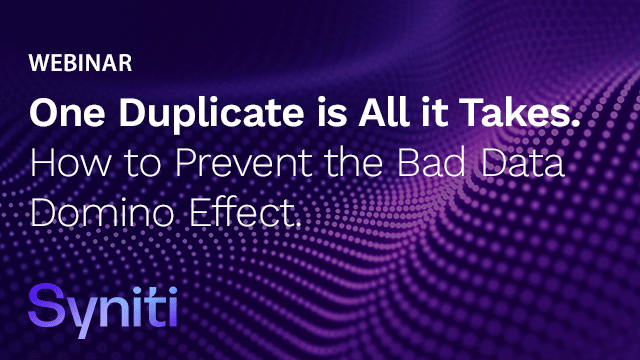
Enterprise Data Matching Software
Cure your duplicate data pain with smarter matching. Syniti Match enables organizations to unlock a clear, connected view of customer and supply chain data for actionable business insights.






Catch Duplicates Before They Catch You
Maintaining high-quality, accurate data can be challenging when your organization deals with customer, vendor, and supply chain data stored across various systems. Syniti Match helps enterprises address data quality issues before they impact business operations.
Fuel Your Enterprise with Data in Context
We’ve perfected the science of matching to help data-driven organizations solve their most complex challenges. Our solution helps enterprises rapidly connect disparate data at scale so you can make smarter business decisions – faster.
Gain actionable business insights with clean, connected data
Create a rich, singular view of real-world entities to enhance strategic and operational decisions. Drive greater business value by powering your analytics programs with clean, connected data.
Streamline Your Move to S/4HANA
Our data matching solutions help reduce the time spent on business partner harmonization by 75% on your journey to SAP S/4HANA.
Target Customers with Greater Precision
Drive revenue and brand reputation. Syniti Match enables a 360-degree connected customer view, so your organization can create more personalized and consistent customer experiences across channels.
Reduce Risk and Costs
Avoid costly inconsistencies and improve GDPR and CCPA compliance with the ability to identify and connect data about individuals across disparate systems and sources.
Duplicate Data Cost Calculator
How much is duplicate data costing your business?
Cost Profile Scenario Comparison
*This tool is provided solely for illustrative purposes. Syniti disclaims all representations and warranties as to the information provided, and any resulting calculations should not be construed as an offer.
Ignite business performance with our built for purpose software
Identify matches in a sub-second with real-time ingestion mode to prevent duplicate record creation or leverage batch mode to identify duplicates in large data volumes.
Cloud-native software supports hybrid and full cloud deployment options, offering greater control and flexibility to support your enterprise infrastructure.
Organizations can match millions of records each day with no limit on the number of records that can be ingested. Our smart settings intuitively scale with the volume and variety of your data.
Reduce time spent on manual data preparation. Syniti’s data matching solutions are capable of deduplicating your customer data as-is, with zero wrangling required.
Drag and drop interface minimizes reliance on data scientists and expert users, so you can reduce strain on technical resources and accelerate time-to-insight.
Customer Success Stories
One Duplicate Is All It Takes: How to Prevent the Bad Data Domino Effect
Do you know how much duplicate records are costing your business? Learn how organizations can establish a proactive data quality strategy to prevent poor data from impacting their bottom line.
Powering iconic enterprises with better data
Combat CRM Duplication
Achieve a single view of the customer to deliver consistent, high-quality experiences and win the battle against broken customer journeys.
Simplify SAP Migrations
Address data first in your journey to SAP S/4HANA. Syniti streamlines business partner harmonization, so you’ll move clean, consolidated data to the new system.
Transform Vendor Management
Align vendor spending records to identify qualified volume discounts and uncover millions in potential procurement savings.
Unlock Greater Inventory Visibility
Find and fix duplicate and incomplete inventory records to gain greater supply chain visibility and control.

